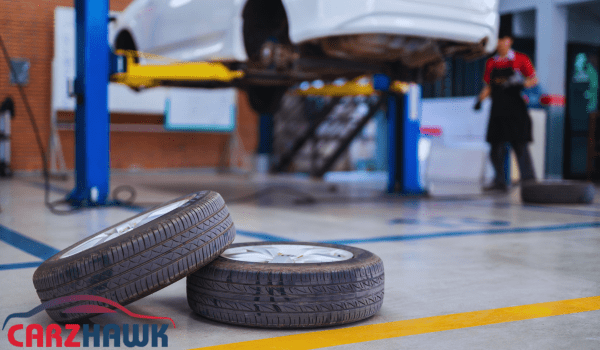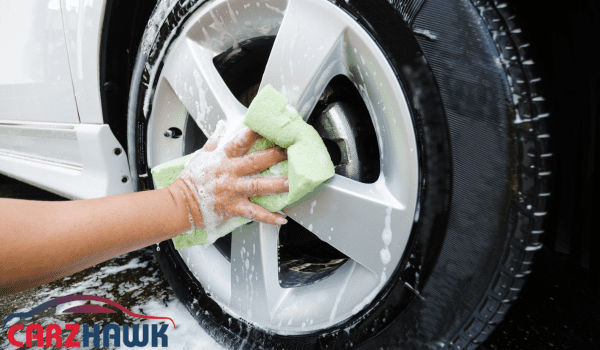The Tire Pressure Sensor Fault Ford dashboard flashes a warning light even though your tire pressure is acceptable. This means that the tire pressure sensor is broken.
It needs to be reset to work right, and we’ve looked into how to do that. Here’s how to make the Ford tire pressure sensor work again:
- Just put your foot on the brake pedal and wait three seconds. Then, take your foot off the stop.
- Three times, press and hold the start button. If the ignition needs a key, use the key to turn the engine on. Don’t turn the key.
- Finish with the “On” mode on the third push. You will hear a beep each time you push the on/off button.
- Do steps 1 through 3 again.
- The “Train Left Front Tire” message will appear on your screen. That sign means that the tires are now being trained.
- The lessons will start on the left front tire and go around to the right front tire, the right rear tire, and finally, the left rear tire.
- Press the start button again when you’re done, and two beeps will sound. Do it again if you don’t hear any beeps.
This method works for Ford cars made between 2011 and 2021. You shouldn’t reset your Tire Pressure Sensor Fault Ford There if there are radio waves around. The wavelengths will mess up your results.
You can clear the Ford tire pressure indicator in other ways as well. This post shows you how to fix a problem with the tire pressure sensor that only happens in specific Ford models. Read on to find out more about these problems.
Is it safe to drive if the tire pressure sensor is broken?
One or more of your car’s tires may have too much or too little air, which could mess up the tire pressure sensor.
You are putting yourself, your people, and other cars in danger if you keep driving with too high or too low tires.
When tires don’t have enough air, they can blow out and cause an accident. Sidewalls can bend if there isn’t enough air in the tires. This makes the tires rub against the road more, which creates friction and heat.
Too much heat will cause some of the rubber in the tire to separate from the wheel. You could have a tire blowout in these conditions, especially if you’re going fast on the highway.
A Tire Pressure Sensor Fault Ford can also cause too-high tire pressure. This is just as bad.
If you hit a pothole or a sharp rock, tires with too much air can blow up like a blown-up balloon. You might get scared, lose control of the wheel, and hit something.
If you get a fault code for the tire pressure monitor, first think your tires have too little or too much air pressure. Use a tire measure to check the pressure in all of your tires.
This should be done when the tires are cold, three hours after the last drive, or first thing in the morning.
If the tires are too filled, let the air out of them. As you let the air out of the tire, check until it hits the right psi.
If the tire doesn’t have enough pressure, use an air pump to add air until the proper psi is reached.
Besides low air pressure, a tire pressure monitor fault can happen if the batteries die or the metal valve stems rust.
If the batteries are dead or the valve stem is rusty, the TPMS should be replaced with a new one.
The sensor warning could be caused by a lost link, like driving over a bump or a hole.
A sensor warning signal can also be sent if you change your tires and the new ones are not linked to the system.
How to Make the Tire Pressure Sensor Fault Ford Work Again
These steps will help you reset a Ford tire pressure sensor:
- Take a 10-minute drive at 50 mph. After that, leave the car alone for 20 minutes.
- Don’t run the engine when you press the start button. Keep your finger on the button for the tire pressure indicator until the “fault” message blinks three times. Take your finger off the button, and then start the engine.
- All tires should have 3 psi more air than what is suggested. Then make them almost empty. After letting the tires lose air, pump them back up to the suggested psi.
Ford Fusion Tire Pressure Sensor Fault
A mid-sized car with a 2.0L or 2.3L engine, the Ford Fusion was made from 2006 to 2012. This is a high-end car with many excellent features and a roomy cabin.
If you see or hear a message or icon that says “tire pressure sensor fault,” you can reset it after ensuring the tire pressures are at the right level.
To reset the Tire Pressure Sensor Fault Ford Fusion with a critical start from 2006 to 2012, follow these steps:
Set the sensors on the cars to “train mode.” Put the key in the ignition and step on the brake hard. Then let go of the brake.
The key should be turned on and then off. Do this three times, finishing the third time with the On mode.
Once more, press the brake pedal and let go of it. Three times, turn the key on and off. At the end of the third time, make sure it’s ON.
After three beeps, the tires will be in the train setting, and the monitor will show the following message: “Train Left Front Tire.”
To train each tire separately, get out of the car and use a diagnostic tool or reader.
You must first set up the tool by picking the year, the make (Ford), and the type (Fusion). Pick “Manual Relearn” to teach each tire in turn.
Hold the scanner close to the sensor and press the scan button. Start by pressing “start.” The tire is now trained to go flat when the horn sounds. Click “Ok.”
Do this again with all four tires. This will cause the dashboard to flash the word “Training Complete.”
Trouble with the Ford Focus Tire Pressure Sensor
All four tires on third-generation Ford Focus models (2012–2019 in the U.S.) have 35 psi tires that the maker put on. This is what you do to fix the tire pressure sensor fault:
Fill up all four tires with air using an air pump to 40–45 psi. Then, get into the driver’s seat of your Ford Focus.
Just press the start button once without stepping on the brakes. Hold the key and turn it once, but don’t start the engine.
Then quickly press the accident light button six times. There will be a beep and a sign on the panel that says “Train Left Front Tire.”
Remove the air from the left front tire first after getting out of the car.
Take off the cap on the valve stem and use a screwdriver to press down on the metal pin in the middle of the valve until you hear two honks. Put the cap back on and stop pushing.
Start with the right front tire, the right rear tire, and finally, the left rear tire. Do this for each tire in a clockwise direction. There will be a honk every time one of the tires loses air.
Turn off the car when you get back inside. You should no longer see the “fault sensor” message when you turn it back on.
Trouble with the Ford Edge Tire Pressure Sensor
Ford Edge has been on the market since 2007 and is now in its second generation as a crossover SUV. It comes in types that run on gasoline and diesel.
It’s the same way to fix the Edge’s Tire Pressure Sensor Fault Ford as it is with other Ford cars:
First, fill up all tires to the psi level the manufacturer recommends. Then, step on the brakes and let go.
To finish the third time, turn the critical three times, finishing the third time with the Engine On.
Once more, press the stop and then let go of it.
Turn the critical three times while the car is running and leave it on the third time.
You’ll hear the horn once and see “Train Left Front Tire” on the screen. This means that the training mode has started.
With a diagnostic tool, check each tire counterclockwise (left front tire, right front tire, right rear tire, left rear tire). Get out of the car and do this.
The horn will sound once to inform you that the train has passed after each scan. “Training Mode Complete” will show up on the screen.
Don’t start the engine.
Trouble with the Ford Mustang Tire Pressure Sensor
Ford has made the famous Mustang for the longest time.
It comes in many styles, from the simple Ecoboost engine to the powerful GT. The TPMS in your Mustang may go to sleep mode and show a tire pressure sensor problem message if it hasn’t been moved or driven for a while.
A Ford expert trained it and woke it up by doing these things:
Take the negative battery wire off and wait ten minutes. Then press down on the brake and let go of it.
Then you should press the start button and make sure it is on. The TPMS on the panel will not have any sensor data yet.
Start the car and go. The number on the back wheels should return to 33 after two minutes. Once ten minutes have passed, the front tires should show 32 and 34 psi again.
The TPMS shouldn’t show a fault message again when you turn the car on the next time. Don’t drive for a long time with the negative battery wires disconnected, and after resetting, don’t forget to connect the cable.
Conclusion
The TPMS is meant to give you real-time details about how your car’s tires are doing. Its main job is to keep you safe by letting you know when something isn’t normal.
If the tires are too low on air or for some other reason, your Ford’s dashboard will show a tire pressure monitor fault. Find out what’s wrong and reset the TPMS until it works again.







